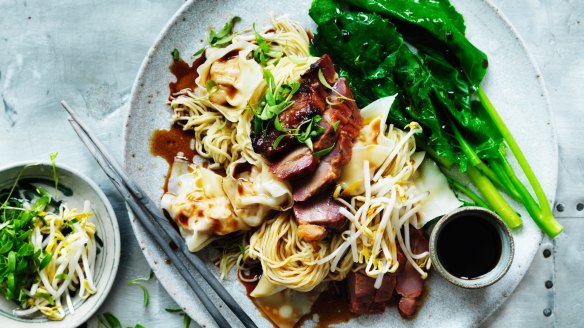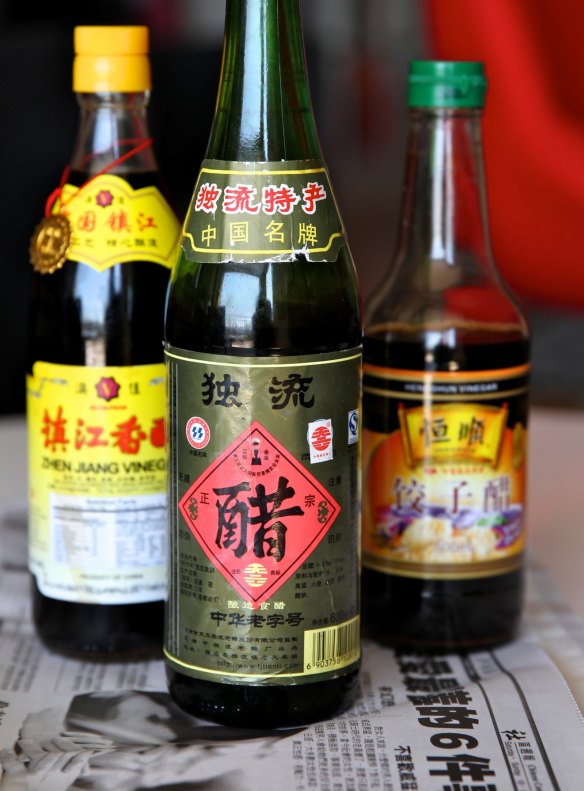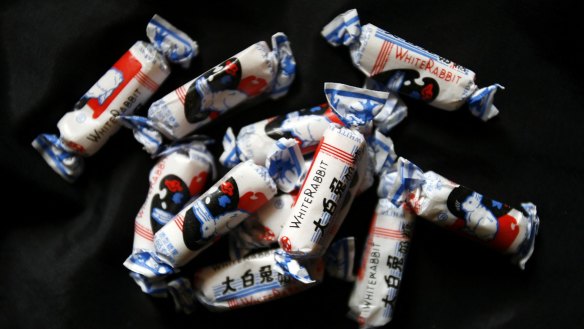Asian supermarkets 101: How to shop and stock your pantry

- Recipe: Adam Liaw's dry wonton noodles (pictured above)
Walking into an Asian grocery store for the first time can be a daunting experience.
But don't be intimidated. We've broken down what Asian supermarkets generally carry into a few categories, so you'll realise it's much simpler than you thought.
I've been going to Asian grocery stores with my Chinese-Indonesian mother since I was a small child. I asked her to point out some items that were must-haves for someone looking to make Asian food in their own kitchens. From fresh produce to canned goods, here are her recommendations for your shopping list.
Sauces, vinegars, oils
Hoisin sauce
Used in cooking, as a condiment and as a marinade, this sauce is sweet, thick and savoury. Try dipping roasted duck in it or brushing it over salmon before grilling.

Chinkiang vinegar
Also known as Chinese black vinegar, this rice-based black vinegar is used in cooking and as a dipping sauce. Its sour, slightly sweet, earthy and pungent flavour is great for dumplings and as a base for other sauces.
Oyster sauce
It's often used as a topping for steamed vegetables, like gai lan (see produce below). Drizzle the sauce on top after steaming. Done. The savoury sauce is slightly seafoody with a caramel-like taste and texture.
Sesame oil
A little goes a long way for this fragrant, nutty oil. Great for stir-fries and braising. Use a tiny amount, and add more if you dig it. Don't forget to refrigerate it, so it doesn't go rancid.
Rice wine
Another heavy lifter, rice wine can be used in pretty much everything. Try mixing it into a dumpling filling, making a sauce with soy sauce or flavouring cooked noodles for chow mein.
Produce and meat
Gai lan
Often referred to as Chinese broccoli or Chinese kale, it has a slightly bitter flavour and pairs well with savoury side dishes. Stir-fry it with ginger and garlic, or steam or boil it and add a drizzle of oyster sauce. Packed with vitamins A and C, iron, potassium and calcium, it's an easy way to add a green, leafy vegetable to your diet.
Snow pea tips
One of my favourite Asian vegetables, these are crunchy with slightly hollow stems. The flavour is similar to a snowpea, but slightly more aromatic with a fresh, sweet, grassy aftertaste. Try stir-frying them with garlic and serving as a side.
Chinese chives
A little garlicky, a little oniony, a little leeky, this versatile vegetable is often stir-fried with eggs, wrapped into dumplings or mixed in batter for a pan-fried pancake.
Live fish
Live fish are thwacked, gutted and scaled in the store. At home, rub it down with some salt and steam the entire fish in ginger, spring onion, and soy sauce. If the prospect of dealing with a whole live fish is challenging, you can also find packaged versions.
Oxtail
This is a cut used in many cuisines around the world, but my favourite two styles are braised or in a soup. The oxtail cooks down nice and tender when braised. In soup, the fat creates a silky broth that is comforting and satisfying. Try making oxtail soup with a simple preparation of carrots, celery, potatoes and tomatoes.
Jarred and canned
Pork floss
This dried-pork product can top congee or is used as a filling in buns and wraps. As a child, I would just eat it by the spoonful. Think of it as a fluffier version of pork jerky.
Water chestnuts
You can choose fresh or canned, depending on how you're going to use them. If you're just looking for the crunch factor, the canned version will save you some work. Try them in fried rice or a dumpling filling.
Wheat gluten
I'll admit that this item isn't essential, but it's a big part of congee culture. Pickled cucumbers and wheat gluten are bright, sweet toppings for hearty, comforting congee.
Lao Gan Ma
This chilli oil has a cult following for a good reason: It tastes great on everything. Fried rice, noodles, sauces, scrambled eggs, whatever. Mix in a little or a lot – this tingly, crunchy, salty, umami chili oil with preserved black soy beans is the real deal.
Five spice
This powder is made of ground cumin, star anise, cinnamon, peppercorns and cloves, and is used heavily in meat dishes as a dry rub or part of a marinade.

Packaged
Dumplings
You'll find myriad brands, styles and flavours of dumplings at any Asian grocer. Some are fully cooked and just need to be heated up, while others need a little more work because the filling is raw.
Wonton wrappers
When you're feeling ambitious and want to make your own dumplings, save a lot of time by buying wonton wrappers. They come thinly sliced and ready to fill with your own creation.
Noodles
Dried rice noodles, vermicelli, egg noodles and flour noodles are staples that are easy to rehydrate and cook. Try putting noodles in soup or stir-frying egg noodles with vegetables and sesame oil.
Dried shiitake mushrooms
Rehydrate by putting them in some water for 10 minutes. Then, slice and toss them into a stir-fry, fried rice, claypot, hotpot or a dumpling filling. They're also great in frittatas with some goat's cheese.
Snacks
The choices are endless. Try honey crisp bars (which are crunchy and sweet), crackers (try something with a seaweed dust) or White Rabbit lollies – think the flavour of a vanilla milkshake and the texture of a Starburst.
TNS
The best recipes from Australia's leading chefs straight to your inbox.
Sign up- More:
- How to